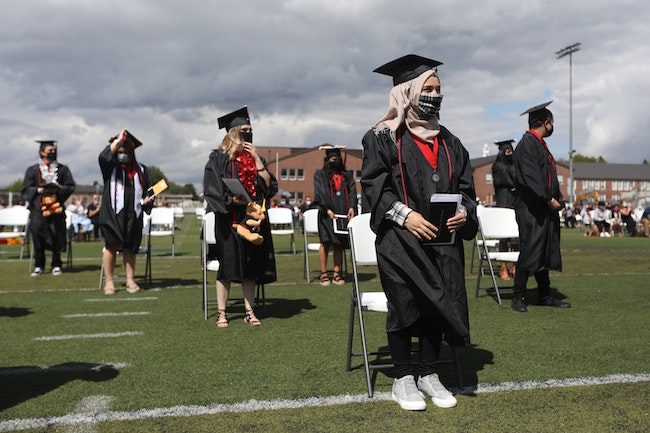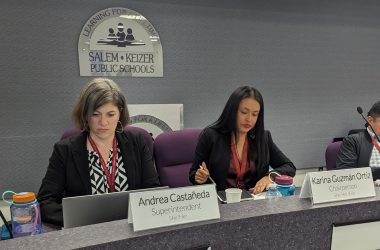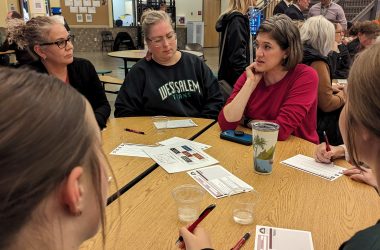 Majida Aryan and other North Salem High School seniors stand during their graduation ceremony on Thursday, August 6. (Amanda Loman/Salem Reporter)
Majida Aryan and other North Salem High School seniors stand during their graduation ceremony on Thursday, August 6. (Amanda Loman/Salem Reporter)
Stacie Creighton spent her summer knocking on doors, tracking down North Salem High School seniors.
Creighton, an assistant principal at the high school, was on a mission: get more students to earn a high school diploma.
She worked with school counselors and teachers to find students who still needed to finish classes to graduate on time. Often, she said, they encountered parents who had lost hope and believed it was too late for their child to earn a diploma.
“The final question was, ‘Can my son or daughter, still graduate?’” she recalled. “And we’re like, ‘Absolutely, but this is what they need to do.’”
Both Oregon and the Salem-Keizer School District saw gains in graduation rates for the Class of 2020. With the pandemic shuttering schools around the state in March and education officials waiving standardized testing requirements for graduation, it’s unclear what role looser standards for earning a diploma played in the numbers.
In Salem-Keizer high schools, 2,482 local seniors earning a diploma in four years. Oregon posted an 83% graduation rate, its fourth straight year of improvement. Salem-Keizer saw 81% of seniors graduate, up from 79% in 2019.
“We’re excited and very proud of the kids for just sticking with it,” said Larry Ramirez, Salem-Keizer’s director of high school education.
Most district high schools saw improvements in graduation rates. North, which has historically had the lowest rate of the district’s six traditional high schools, posted the biggest gains: 83% of the Class of 2020 graduated in four years, compared with about 76% last year.
Those numbers came during a year of widespread disruption for Oregon students because of the Covid pandemic.
Oregon Gov. Kate Brown ordered all schools in the state to close their doors in mid-March. In early April, the Oregon Department of Education said seniors who were passing classes when schools closed would receive full credit for them, effectively graduating much of the Class of 2020 two months early.
That announcement meant about 1,900 Salem-Keizer seniors were done with school, district officials said at the time. Educators turned their focus to seniors close to graduating, but not quite there, helping more than 500 additional students earn diplomas before Oregon’s August cutoff.
The Oregon Department of Education also waived some graduation requirements. Students still had to earn all required credits. But other state requirements to demonstrate “essential skills” in reading, writing and math – typically done through state standardized tests or work samples – were waived.
Colt Gill, Oregon’s schools chief, said he doesn’t believe those changes accounted for the rise in graduation rates, noting the state has posted similar increases in recent years.
He said students who were on track to graduate when schools closed and passing required courses “were not the students that were at risk of not graduating.”
Allowing teachers to focus their efforts on seniors who had yet to complete required classes may have also boosted graduation rates, he said.
“I do think that that could make a difference and I hope it’s something that schools and states learn from,” he said. He said essential skills usually aren’t holding students back from graduating.
Oregon Senate Republican leaders pushed back at the agency’s rosy assessment of the data, saying the gains reflected lower standards and waiving the testing requirement.
“Schools and students went through and overcame many difficulties during the pandemic,” Oregon Senate Republican Leader Fred Girod, R-Lyons, said in a statement. “But for the Governor and her Education Department to pretend that these new statistics somehow indicate a higher quality of education for our kids, particularly for our minority communities for whom we know the impact of school closures was disproportionate, is ridiculous. We should not rely on statistics from a year that caused so much disruption to education to give us insights on how well our schools are doing at educating our kids.”
At North, assistant principal Carlos Ruiz said the shift helped as he talked to students who were close to completing a diploma. Passing essential skills was one less thing they had to worry about.
“All that stuff can get really overwhelming for students that have work responsibilities, home responsibilities,” he said. When he told them that requirement had been waived, “I saw the body language and the eyes of our students change.”
Ruiz said waiving those requirement may have made graduating easier for some students, but educators also faced added challenges tracking down students after classes shifted online and getting them to finish assignments when attendance at school was no longer required.
“As much as people may argue that it’s an easier year, you could argue too that it was more complex or more complicated because students had the freedom to not go to school,” Ruiz said.
The improvements at North come after a three-year effort to identify seniors who were close to graduating, but would likely struggle to finish all the requirements without extra help.
In 2018, the school began working closely with those students during their last semester of high school, asking each to pick an adult in the building who could help them make it to graduation.
Last year, school administrators identified about 65students the summer before their senior year, Ruiz said.. That gave school staff more time to work with them through twice-weekly meetings to help them catch up in classes they were making up work for.
A few transferred from North to another school during senior year, but all who remained graduated, Ruiz said.
“The credit goes to our students and our staff who just worked tirelessly,” he said.
North and McKay high schools were the first to begin tracking struggling students and nudge them toward graduation. But Ramirez said all district high schools now have similar programs in place.
Though most groups of students improved graduation rates, the 2020 numbers still show challenges for many.
Just 54% of homeless students graduated on time in 2020, up from 48% in 2019. Students who weren’t proficient in English at the start of high school posted similarly low numbers, up slightly from 2019. But still well below the district average. Ramirez said that number remains “significantly lower than what I would want.”
While most racial and ethnic groups also saw gains, Pacific Islander students fell back slightly to a 72% graduation rate after a big increase in 2019 to 78%. Still, that rate is up significantly from just 51% of Islander students graduating on time in 2015.
White students make up 47% of the district and Latino students 41%. Other racial and ethnic groups Oregon tracks are about 1 to 2% of the district each, which means graduation rates tend to fluctuate more year-to-year.
Native American students haven’t seen the sustained growth in graduation rate that most other racial groups have. Since 2014, between 56 and 70% of Native students have graduated on time, and the number fell in 2020 to 65%.
The district hired outreach workers in 2018 to help boost graduation rates for Islander and Black students and is planning to hire more outreach workers for the Indian Education team to do similar one-on-one work with students.
Contact reporter Rachel Alexander: [email protected] or 503-575-1241.
WE GET SALEM THE FACTS. Covering your community with care and depth. Salem Reporter – fair, accurate, independent. Subscribe and support our essential local service.

Rachel Alexander is Salem Reporter’s managing editor. She joined Salem Reporter when it was founded in 2018 and covers city news, education, nonprofits and a little bit of everything else. She’s been a journalist in Oregon and Washington for a decade. Outside of work, she’s a skater and board member with Salem’s Cherry City Roller Derby and can often be found with her nose buried in a book.









